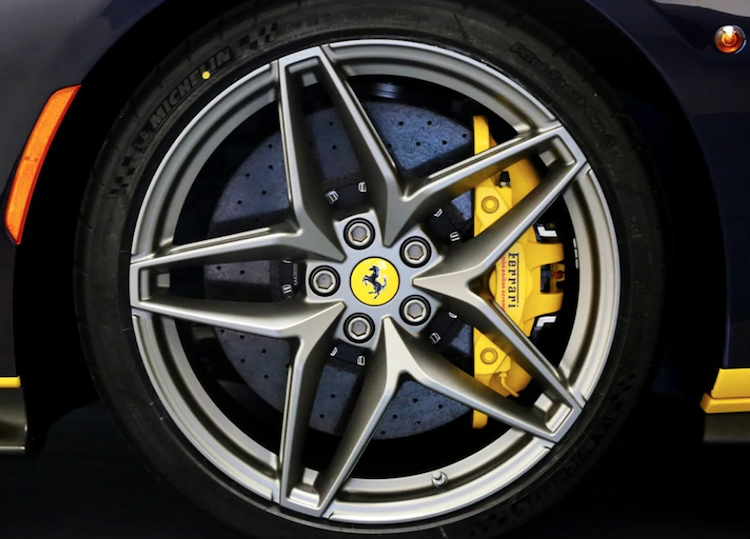The potential failure of Ferrari’s braking system affects 23,555 vehicles manufactured from 2005 to present day. The company blames the problem on a non-vented brake fluid reservoir cap. We know for certain that a vehicle equipped with the new, vented brake fluid reservoir cap lost its brakes without warning. Clearly, there is something else seriously amiss.
To understand what might be causing the failure, I asked an experienced Ferrari mechanic to provide readers with a Ferrari Brakes for Dummies guide to Ferrari’s braking system. Here’s his step-by-step analysis of how it works, and what could possibly go wrong . . .

The image illustrates the hydraulic system in a braking system. (Click here for the animation.)
Let’s break it down, starting at the front end: the brake pedal. It works in much the same way as a pry bar moving a heavy object.

In the picture above, a pry bar reduces the force required to remove a nail. The trade off: the distance the pry bar has to move is sacrificed at point A in relation to point O for a reduction in force applied at point A for amplified force at point O. This concept also applies to hydraulic systems in the picture bellow.

In this diagram, the two pistons are different sizes. The forces applied and distances moved are not equal. This is how an automobile’s basic braking system operates.
The main difference: if one applied a force on F2, the system would have to move all the brake system’s pistons. In sports cars, this can be as many as eight pistons.

Fluid displacement is the key component to Ferrari’s braking system. Pressing the brake pedal displaces fluid. Releasing the pedal displaces fluid in reverse. As you can see, the master cylinder has to displace a large volume of brake fluid to activate eight pistons (represented by the little rectangles on the wheels).
The brake pedal acts as a pry bar on the master cylinder, reducing the effort required to displace the brake fluid. But the brake pedal doesn’t generate enough force to get the job done – a brake booster reduces the load. [ED: click here to read our article on possible brake booster failure.] To appreciate its value, press the brake pedal with your engine switched off, without the brake booster engaged.
Physics tells us fluids don’t compress. Gasses do. If there’s air in any component of the Ferrari’s braking system, it will compress. The more it compresses, the longer the brake pedal travel required to displace the fluid (i.e., activate the brakes). The result is often called “spongy brakes.”
Brake fluid is alcohol-based. It’s extremely hygroscopic – it absorbs water. In liquid form, water has the same properties as brake fluid – it doesn’t compress. But when you apply the brakes to a vehicle, the brake calipers squeeze the brake disc, creating friction. Friction creates heat. If the brakes generate heat greater than 212 °F, the water in the braking system turns to vapor.
The vapor has the same effect on the braking system as air – the pedal travel needed to activate the brakes increases. If enough water turns into vapor, the pedal will “bottom out.” It can’t displace enough fluid to make the system function. The brakes fail. Ferrari’s vented cap recall fix is designed to release water vapor.

This diagram shows the inner workings of a modern master brake cylinder – in this case a dual circuit system controlling front and rear brakes. [ED: the top of the fluid reservoir in this image is vented.]
The brake fluid enters the reservoir via the intake ports. Pressing the brake pedal (via the pushrod) forces fluid into the system. Two rear seals block the intake passages. The fluid is displaced to the two outlet ports. When the force on the pushrod is released – by releasing pressure on the brake pedal – the return spring allows the fluid to return back into the reservoir.
Normally, the brake fluid transfer exerts a mild negative pressure on the fluid in the reservoir. But if there’s vapor and the reservoir is sealed, the vapor creates a positive pressure. If there’s enough positive pressure, it can force brake fluid out of the equalisation port through the bore hydraulic seal.
If the pressure in front of the rear seal increases, it can block the inlet and return port. The pressure in the system can’t release; the brakes will “drag.” The heat in the system will build rapidly, the brake fluid will expand. The brake fluid will apply more pressure to pistons on the calipers. It will continue to do so until and unless it escapes, usually through one or more of the master cylinder seals.
There are other points of failure. If the rubber on the rear seals expands due to rubber/brake fluid compatibility problems, it will block the intake and return port. If the pushrod and brake pedal components are misadjusted or the wrong specification (most modern systems have no adjustment), the intake return port would seal and the same set of problems will occur.
ED: Something is going wrong with Ferraris’ braking system. Ferrari’s vented cap solution tackles one, perhaps even the main problem. But the brake failure of a car with a vented cap indicates there are other issues. Without serious engineering tests, it’s impossible to tell what else might be wrong with Ferrari’s braking system.
As we reported, Bosch performed tests on at least seven Ferraris that lost their brakes. They told the NHTSA they couldn’t find the “root cause” of those failures. Neither Ferrari nor Bosch have released the tests or the results. A class action lawsuit has requested the documents. We’ll keep you up-to-date.
